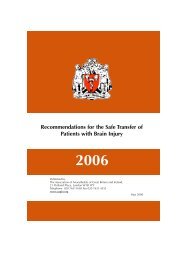TheatrePracticeStandardsGeneric1
Create successful ePaper yourself
Turn your PDF publications into a flip-book with our unique Google optimized e-Paper software.
Generic Theatre Standard No 13 - Management of Clinical Specimens<br />
Standard: Collection of specimens and transportation to the laboratory.<br />
Standard Statement: In the operating theatre, specimens are regularly taken during surgical<br />
procedures. It is essential that every specimen reaches the pathology, bacteriology, histology or<br />
cytology department without undue delay and in optimum condition, to facilitate the survival and<br />
identification of organisms.<br />
Method:<br />
• Collection of a sample: Classification of Specimens<br />
• Specimens fall into three categories:<br />
o<br />
o<br />
o<br />
Transfusion specimens<br />
Retrievable specimens<br />
Irretrievable specimens<br />
• RCHT Pathology has classified irretrievable specimens as:<br />
• Cerebrospinal fluids (CSFs)<br />
• Specified dynamic function tests & specific test requirements<br />
• Bone Marrow specimens<br />
• Amniotic Fluids<br />
• Histological and Cytological samples (excluding voided urines and sputa)<br />
• Some samples from post mortems<br />
• Certain forensic samples under the auspices of a Pathologist<br />
• Clinical Microbiology - Sterile fluids, Outbreak samples other than faeces, specimens<br />
from temporary residents, specimens from the operating theatre.<br />
ALL OTHER SPECIMENS ARE ‘RETRIEVABLE’ i.e. ABLE TO BE REPEATED<br />
• Documentation requirements: Recording of Specimens<br />
• All entries into any health record, including amendments, must be clearly dated, timed,<br />
signed and the designation of the person making the entry must be clearly recorded.<br />
• The Theatre Manager will retain copies of signatures of all healthcare professionals<br />
who make entries on healthcare records, together with the professional's registration<br />
number (NMC or HPC). The register of signatures will be reviewed and updated<br />
annually.<br />
• It is the responsibility of the requester to ensure that specimens and forms are correctly<br />
labelled.<br />
• It is the responsibility of the person sending the specimen to ensure that samples and<br />
forms are correctly labelled to the agreed standards<br />
• It is the responsibility of the medical practitioner to sign the request form and state what<br />
particular investigations are required. This should generally be the surgeon, but on<br />
occasion may be another medical practitioner such as the anaesthetist. Whoever<br />
provides the detail must supply all information, including clear identification of who they<br />
are, their grade, and their contact details.<br />
62





